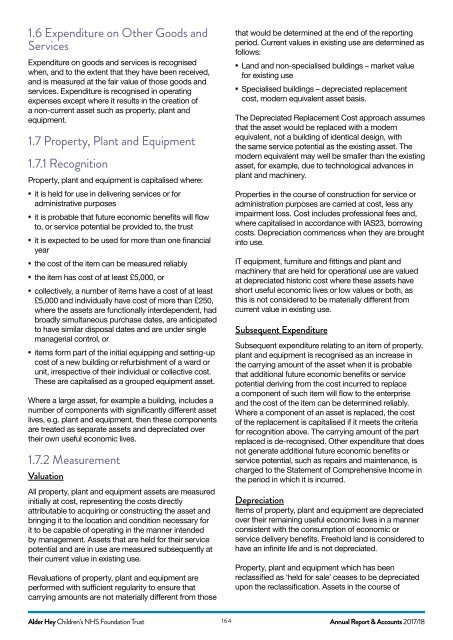AH ANNUAL REPORT 2018
Create successful ePaper yourself
Turn your PDF publications into a flip-book with our unique Google optimized e-Paper software.
1.6 Expenditure on Other Goods and<br />
Services<br />
Expenditure on goods and services is recognised<br />
when, and to the extent that they have been received,<br />
and is measured at the fair value of those goods and<br />
services. Expenditure is recognised in operating<br />
expenses except where it results in the creation of<br />
a non-current asset such as property, plant and<br />
equipment.<br />
1.7 Property, Plant and Equipment<br />
1.7.1 Recognition<br />
Property, plant and equipment is capitalised where:<br />
• it is held for use in delivering services or for<br />
administrative purposes<br />
• it is probable that future economic benefits will flow<br />
to, or service potential be provided to, the trust<br />
• it is expected to be used for more than one financial<br />
year<br />
• the cost of the item can be measured reliably<br />
• the item has cost of at least £5,000, or<br />
• collectively, a number of items have a cost of at least<br />
£5,000 and individually have cost of more than £250,<br />
where the assets are functionally interdependent, had<br />
broadly simultaneous purchase dates, are anticipated<br />
to have similar disposal dates and are under single<br />
managerial control, or<br />
• items form part of the initial equipping and setting-up<br />
cost of a new building or refurbishment of a ward or<br />
unit, irrespective of their individual or collective cost.<br />
These are capitalised as a grouped equipment asset.<br />
Where a large asset, for example a building, includes a<br />
number of components with significantly different asset<br />
lives, e.g. plant and equipment, then these components<br />
are treated as separate assets and depreciated over<br />
their own useful economic lives.<br />
1.7.2 Measurement<br />
Valuation<br />
All property, plant and equipment assets are measured<br />
initially at cost, representing the costs directly<br />
attributable to acquiring or constructing the asset and<br />
bringing it to the location and condition necessary for<br />
it to be capable of operating in the manner intended<br />
by management. Assets that are held for their service<br />
potential and are in use are measured subsequently at<br />
their current value in existing use.<br />
Revaluations of property, plant and equipment are<br />
performed with sufficient regularity to ensure that<br />
carrying amounts are not materially different from those<br />
that would be determined at the end of the reporting<br />
period. Current values in existing use are determined as<br />
follows:<br />
• Land and non-specialised buildings – market value<br />
for existing use<br />
• Specialised buildings – depreciated replacement<br />
cost, modern equivalent asset basis.<br />
The Depreciated Replacement Cost approach assumes<br />
that the asset would be replaced with a modern<br />
equivalent, not a building of identical design, with<br />
the same service potential as the existing asset. The<br />
modern equivalent may well be smaller than the existing<br />
asset, for example, due to technological advances in<br />
plant and machinery.<br />
Properties in the course of construction for service or<br />
administration purposes are carried at cost, less any<br />
impairment loss. Cost includes professional fees and,<br />
where capitalised in accordance with IAS23, borrowing<br />
costs. Depreciation commences when they are brought<br />
into use.<br />
IT equipment, furniture and fittings and plant and<br />
machinery that are held for operational use are valued<br />
at depreciated historic cost where these assets have<br />
short useful economic lives or low values or both, as<br />
this is not considered to be materially different from<br />
current value in existing use.<br />
Subsequent Expenditure<br />
Subsequent expenditure relating to an item of property,<br />
plant and equipment is recognised as an increase in<br />
the carrying amount of the asset when it is probable<br />
that additional future economic benefits or service<br />
potential deriving from the cost incurred to replace<br />
a component of such item will flow to the enterprise<br />
and the cost of the item can be determined reliably.<br />
Where a component of an asset is replaced, the cost<br />
of the replacement is capitalised if it meets the criteria<br />
for recognition above. The carrying amount of the part<br />
replaced is de-recognised. Other expenditure that does<br />
not generate additional future economic benefits or<br />
service potential, such as repairs and maintenance, is<br />
charged to the Statement of Comprehensive Income in<br />
the period in which it is incurred.<br />
Depreciation<br />
Items of property, plant and equipment are depreciated<br />
over their remaining useful economic lives in a manner<br />
consistent with the consumption of economic or<br />
service delivery benefits. Freehold land is considered to<br />
have an infinite life and is not depreciated.<br />
Property, plant and equipment which has been<br />
reclassified as ‘held for sale’ ceases to be depreciated<br />
upon the reclassification. Assets in the course of<br />
Alder Hey Children’s NHS Foundation Trust 164<br />
Annual Report & Accounts 2017/18


